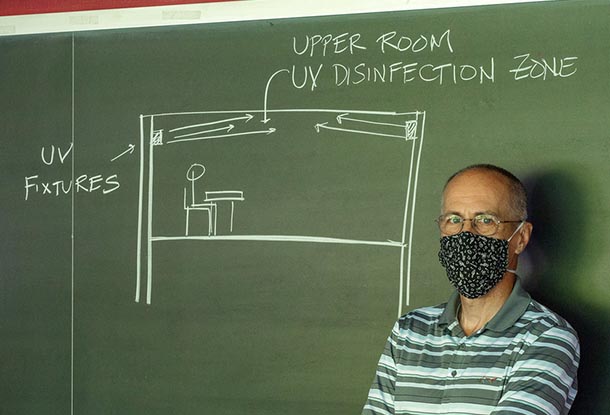
Rick Mistrick, principal investigator and associate professor of architectural engineering, demonstrates what an upper-room disinfection system potentially would look like. IMAGE: KATE MYERS
UV-light research to investigate aerosol disinfection in unoccupied classrooms
9/28/2020
By Mariah Chuprinski
UNIVERSITY PARK, Pa. — As students continue in-person learning, classrooms are a focus of COVID-19 mitigation efforts. A new $125,000 grant, funded by Penn State’s Office of the Physical Plant (OPP), is helping researchers investigate the possibility of aerosol disinfection of classrooms using ultraviolet, or UV, light.
Rick Mistrick, associate professor of architectural engineering, is the principal investigator for the two-year project, titled “Ultraviolet-Germicidal Irradiation for Control of COVID-19 in University Classrooms.”
“Ultraviolet light disinfection seems to be promising compared to other disinfection options,” Mistrick said. “The idea is to expose room air to UV light in the form of a fixture that irradiates roughly the upper two feet of the room volume along the ceiling.”
He explained that the lighting fixture, known as an upper-room system, could be placed at the center of a room or along a wall without taking up much space. Once installed, the light would generally remain on during occupancy and afterward to inactivate virus particles in the air space. Since the fixture focuses the UV light near the ceiling, occupants in the room would not be exposed to the light.
But the method doesn’t come without its challenges. Not all classrooms are ideal to install such fixtures, as some have low ceilings, while others have outdated ventilation and filtration capacities.
Along with co-principal investigator Donghyun Rim, associate professor of architectural engineering, the team is running simulation tests on several real, unoccupied classrooms at Penn State to see how they perform in relation to variables such as classroom size, air diffusion, airflow patterns and control of virus particles discharged into a space. Tests in the unoccupied classrooms will be conducted during off-hours.
“We are focused on running tests on three classrooms, two in Willard Building and one in Hammond,” Rim said. “Once we collect the data, we can present all in-classroom control options to Penn State OPP so they can decide if they want to implement the technology.”
According to Mistrick, there are additional challenges to address before this type of ceiling device could be implemented in any building environment, including that UV light fixtures are expensive and consume energy.
While using UV light to purify air is feasible, there are other systems that direct UV light at reduced intensities into the lower sections of a room to provide surface disinfection, which can inactivate viruses and other pathogens over longer periods of time, Mistrick said.
For these lower-level systems, the exposure conditions must be safe for the occupants of the spaces since the goal of the systems is to irradiate as much of the space as possible. Exposure to UV light above certain levels can cause sunburn and irritate the eye’s cornea — called photokeratitis — which is relatively common if the eyes are not protected, for example, at the beach, or while skiing or hiking.
“It is very difficult to accomplish surface disinfection in inhabited spaces, like academic buildings, because of the risk of exposure to UV light for people walking through or working within the space,” Mistrick said.
Some hotels have applied UV light to disinfect surfaces by using mobile robots to generate UV light while no one is present in the room. UV technology may become more versatile in the future, since new light sources and systems are being studied, including some that may be safer for surface disinfection in occupied rooms, according to Mistrick.
Sez Atamturktur, Harry and Arlene Schell Professor and head of the Department of Architectural Engineering, noted UV lighting disinfection could be a viable solution to disinfect buildings of all types in the future.
“Like other research solutions that have come as a result of COVID-19, Penn State is supporting the most cutting-edge research in lighting and building mechanical systems,” she said.



